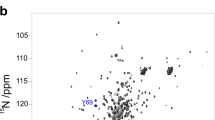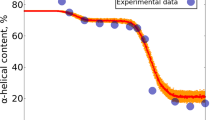Abstract
Magnetization transfer through dipole-dipole interactions (nuclear Overhauser effects, NOEs) between water protons and the protons lining two small hydrophobic cavities in hen egg-white lysozyme demonstrates the presence of water molecules with occupancies of ∼10–50%. Similarly, NOEs were observed between the cavity protons and the protons of hydrogen, methane, ethylene or cyclopropane applied at 1–200 bar pressure. These gases can thus be used as general NMR indicators of empty or partially hydrated hydrophobic cavities in proteins. All gases reside in the cavities for longer than 1 ns in marked contrast to common belief that gas diffusion in proteins is not much slower than in water. Binding to otherwise empty cavities may be a major aspect of the anesthetic effect of small organic gas molecules.
This is a preview of subscription content, access via your institution
Access options
Subscribe to this journal
Receive 12 print issues and online access
$189.00 per year
only $15.75 per issue
Buy this article
- Purchase on Springer Link
- Instant access to full article PDF
Prices may be subject to local taxes which are calculated during checkout
Similar content being viewed by others
References
Ernst, J.A., Clubb, R.T., Zhou, H.X., Gronenborn, A.M. & Clore, G.M. Demonstration of positionally disordered water within a protein hydrophobic cavity by NMR. Science 267, 1813–1817 (1995).
Matthews, B.W., Morton, A.G. & Dahlquist, F.W. Use of NMR to detect water within nonpolar protein cavities. Science 270, 1847–1848 (1995).
Ernst, J.A., Clubb, R.T., Zhou, H.X., Gronenborn, A.M. & Clore, G.M. Use of NMR to detect water within nonpolar protein cavities – response. Science 270, 1848–1849 (1995).
Zhang, L. & Hermans, J. Hydrophilicity of cavities in proteins. Proteins 24, 433–438 (1996).
Buckle, A.M., Cramer, P. & Fersht, A.R. Structural and energetic responses to cavity-creating mutations in hydrophobic cores: observation of a buried water molecule and the hydrophilic nature of such hydrophobic cavities. Biochemistry 35, 4298–4305 (1996).
Schoenborn, B.P., Watson, H.C. & Kendrew, J.C. Binding of xenon to sperm whale myoglobin. Nature 207, 28–30 (1965).
Schoenborn, B.P. Binding of cyclopropane to sperm whale myoglobin. Nature 214, 1120–1122 (1967).
Shulman, R.G., Peisach, J. & Wyluda, B.J. Effects of cyclopropane and xenon upon the high-resolution nuclear magnetic resonance spectrum of ferrimyoglobin cyanide. J. Mol. Biol. 48, 517–523 (1970).
Liepinsh, E. & Otting, G. Organic solvents identify specific ligand binding sites on protein surfaces. Nature Biotech., 5, 264–268 (1997).
Bernstein, F.C., Koetzle, T.F., Williams, G.J.B., Meyer Jr., E.F., Brice, M.D., Rodgers, J.R., Kennard, O., Shimanouchi, T. & Tasumi, M. The protein data bank: a computer-based archival file for macromolecular structures. J. Mol. Biol. 112, 535–542 (1977).
Kodandapani, R. suresh, C.G. & Vijayan, M. Crystal structure of low humidity tetragonal lysozyme at 2.1 Å resolution. Variability in hydration shell and its structural consequences. J. Biol. Chem. 265, 16126–16131 (1990).
Wilson, K.P., Malcolm, B.A. & Matthews, B.W. Structural and thermodynamic analysis of compensating mutations within the core of chicken egg white lysozyme. J. Biol. Chem. 267, 10842–10849 (1992).
Hodsdon, J.M., Brown, G.M., Sieker, L.C. & Jensen, L.H. Refinement of triclinic lysozyme: I. Fourier and least-squares methods. Acta Crystallogr. B46, 54–62 (1990).
Ramanadham, M., Sieker, L.C. & Jensen, L.H. Refinement of triclinic lysozyme: II. the method of stereochemically restrained least squares. Acta Crystallogr. B46, 63–69 (1990).
Kundrot, C.E. & Richards, F.M. Crystal structure of hen egg-white lysozyme at a hydrostatic pressure of 1000 atmospheres. J. Mol. Biol. 193, 157–170 (1987).
Young, A.C.M., Dewan, J.C., Nave, C. & Tilton, R.F. Comparison of radiation-induced decay and structure refinement from X-ray data collected from lysozyme crystals at low and ambient temperatures. J. Appl. Crystallogr. 26, 309–319 (1993).
Lescar, J., Souchon, H., Alzari, P.M. Crystal structure of pheasant and guinea fowl egg-white lysozymes. Protein Sci. 3, 788–798 (1994).
Chitarra, V., Alzari, P.M., Bentley, G.A., Bhat, T.N., Eisele, J.L., Houdusse, A., Lescar, J., Souchon, H. & Poljak, R.J. Three-dimensional structure of a heteroclitic antigen-antibody cross-reaction complex. Proc Natl. Acad. Sci. USA 90, 7711–7715 (1993).
Shih, P., Holland, D.R. & Kirsch, J.F. Thermal stability determinants of chicken egg-white lysozyme core mutants: hydrophobicity, packing volume, and conserved buried water molecules. Protein Sci. 4, 2050–2062 (1995).
Wilson, K.P., Malcolm, B.A. & Matthews, B.W. Structural and thermodynamic analysis of compensating mutations within the core of chicken egg white lysozyme. J. Biol. Chem. 267, 10842–10849 (1992).
Cheetham, J.C., Artymiuk, P.J. & Phillips, D.C. Refinement of an enzyme complex with inhibitor bound at partial occupancy. Hen egg-white lysozyme and tri-N-acetylchitotriose at 1.75 angstroms resolution. J. Mol. Biol. 224, 613–628 (1992).
Hadfield, A.T., Harvey, D.J., Archer, D.B., MacKenzie, D.A., Jeenes, D.J., Radford, S.E., Lowe, G., Dobson, C.M. & Johnson, L.N. Crystal structure of the mutant D52S hen egg white lysozyme with an oligosaccharide product. J. Mol. Biol. 243, 856–872 (1994).
Redfield, C. & Dobson, C.M. Sequential 1H NMR assignments and secondary structure of hen egg white lysozyme in solution. Biochemistry 27, 122–136 (1988).
Otting, G., Liepinsh, E. & Wüthrich, K. Proton exchange with internal water molecules in proteins in aqueous solution. J. Am. Chem. Soc. 113, 4363–4364 (1991).
Ernst, R.R., Bodenhausen, G. & Wokaun, A. Principles of Nuclear Magnetic Resonance in One and Two Dimensions (Clarendon Press, Oxford; 1987).
Bothner-By, A.A., Stephens, R.L., Lee, J., Warren, C.D. & Jeanloz, R.W. Structure determination of a tetrasaccharide: transient nuclear Overhauser effects in the rotating frame. J. Am. Chem. Soc. 106, 811–813 (1984).
Otting, G. & Wüthrich, K. Studies of protein hydration in aqueous solution by direct NMR observation of individual protein-bound water molecules. J. Am. Chem. Soc. 111, 1871–1875 (1989).
Otting, G. & Liepinsh, E. Protein hydration by high-resolution NMR spectroscopy -implications for MR image contrast. Acc. Chem. Res. 28, 171–177 (1995).
Otting, G., Liepinsh, E. & Wüthrich, K. Protein hydration in aqueous solution. Science 254, 974–980 (1991).
Lipari, G. & Szabo, A. Model-free approach to the interpretation of nuclear magnetic resonance relaxation in macromolecules. 2. Analysis of experimental results. J. Am. Chem. Soc. 104, 4559–4570 (1982).
Fogg, P.G.T. & Gerrard, W. Solubility of Gases in Liquids (Wiley, Chichester; 1991).
Lakowicz, J.R. & Weber, G. Quenching of protein flourescence by oxygen. Detection of structural fluctuations in proteins on the nanosecond time scale. Biochemistry 12, 4171–4179 (1973).
Calhoun, D.B., Vanderkooi, J.M., Woodrow III, G.V. & Englander, S.W. Penetration of dioxygen into proteins studied by quenching of phosphorescence and flourescence. Biochemistry 22, 526–1532 (1983).
Handbuch der Anorganischen Chemie, 8th edition, Vol. 2, p. 111 (Verlag Chemie, Weinheim; 1926).
Cusanelli, A., Frey, U., Richens, D.T. & Merbach, A.E. The slowest water exchange at a homoleptic mononuclear metal center – variable-temperature and variable-pressure 170 NMR study on [Ir(H2O)6]3+. J. Am. Chem. Soc. 118, 5265–5271 (1996).
Morton, A., Baase, W.A. & Matthews, B.W. Energetic origins of specificity of ligand binding in an interior nonpolar cavity of T4 lysozyme. Biochemistry 34, 8564–8575 (1995).
Taheri, S., Halsey, M.J., Liu, J. Eger II, E.I., Koblin, D.D. & Laster, M.J. What solvent best represents the site of action of inhaled anesthetics in humans, rats, and dogs? Anesth. Analg. 72, 627–634 (1991).
Gursky, O., Fontano, E., Bhyravbhatla, B. & Caspar, D.L. Stereospecific dihaloalkane binding in a pH-sensitive cavity in cubic insulin crystals. Proc. Natl. Acad. Sci. USA 91, 12388–12392 (1994).
Nakagawa, T., Hamanaka, T., Nishimura, S., Uruga, T. & Kito, Y. The specific binding site of the volatile anesthetic diiodomethane to purple membrane by X-ray diffraction. J. Mol. Biol. 238, 297–301 (1994).
Koblin, D.D., Deady, J.E. & Eger, E.I. Potencies of inhaled anesthetics and alcohol in mice selectively bred for resistance and susceptibility to nitrous oxide anesthesia. Anesthesiology 56, 18–24 (1982).
Smith, L.J., Sutcliffe, M.J., Redfield, C. & Dobson, C.M. Structure of hen lysozyme in solution. J. Mol. Biol. 229, 930–944 (1993).
Connolly, M.L. Atomic size packing defects in proteins. Int. J. Peptide Prot. Res. 28, 360–363 (1986).
Kraulis, P. Molscript: a program to produce both detailed and schematic plots of protein structures. J. Appl. Crystallogr. 24, 946–950 (1991).
Otting, G., Liepinsh, E. Farmer II, B.T. & Wüthrich, K. Protein hydration studied with homonuclearSD 1H NMR experiments. J. Biomol. NMR 1, 209–215 (1991).
Otting, G. & Liepinsh, E. Selective excitation of the water signal by a Q-switched selective pulse. J. Magn. Reson. B 107, 192–196 (1995).
Otting, G. & Liepinsh, E. Selective excitation of intense solvent signals in the presence of radiation damping. J. Biomol. NMR 5, 420–426 (1995).
Geen, H. & Freeman, R. Band-selective radiofrequency pulses. J. Magn. Reson. 93, 93–141 (1991).
Briand, J. & Ernst, R.R. Computer-optimized homonuclear TOCSY experiments with suppression of cross relaxation. Chem. Phys. Lett. 185, 276–285 (1991).
Halle, B. & Wennerström, H. Interpretation of magnetic resonance data from water nuclei in heterogeneous systems. J. Chem. Phys. 75, 1928–1943 (1981).
Lipari, G. & Szabo, A. Model-free approach to the interpretation of nuclear magnetic resonance relaxation in macromolecules. I. Theory and range of validity. J. Am. Chem. Soc. 104, 4546–4559 (1982).
Chiu, Y. Irreducible tensor expansion of solid spherical harmonic-type operators in quantum mechanics. J. Math. Phys. 5, 283–288 (1964).
Sack, R.A. Generalization of Laplace's expansion to arbitrary powers and functions of the distance between two points. J. Math. Phys. 5, 245–251 (1964).
Author information
Authors and Affiliations
Rights and permissions
About this article
Cite this article
Otting, G., Liepinsh, E., Halle, B. et al. NMR identification of hydrophobic cavities with ow water occupancies in protein structures using small gas molecules. Nat Struct Mol Biol 4, 396–404 (1997). https://doi.org/10.1038/nsb0597-396
Received:
Accepted:
Issue Date:
DOI: https://doi.org/10.1038/nsb0597-396
This article is cited by
-
Nonthermal acceleration of protein hydration by sub-terahertz irradiation
Nature Communications (2023)
-
Filling of a water-free void explains the allosteric regulation of the β1-adrenergic receptor by cholesterol
Nature Chemistry (2022)
-
Detecting O2 binding sites in protein cavities
Scientific Reports (2016)
-
McVol - A program for calculating protein volumes and identifying cavities by a Monte Carlo algorithm
Journal of Molecular Modeling (2010)
-
Saposin fold revealed by the NMR structure of NK-lysin
Natural Structural Biology (1997)



